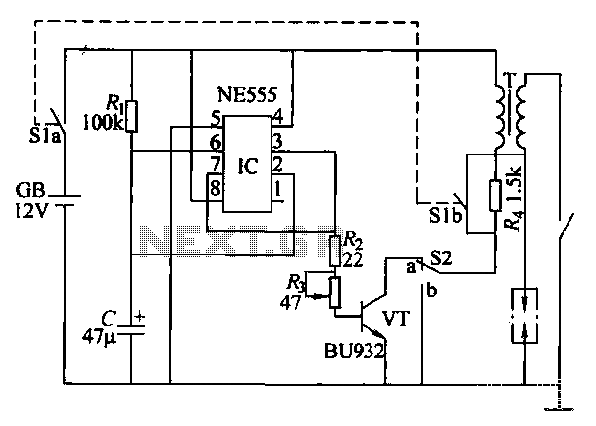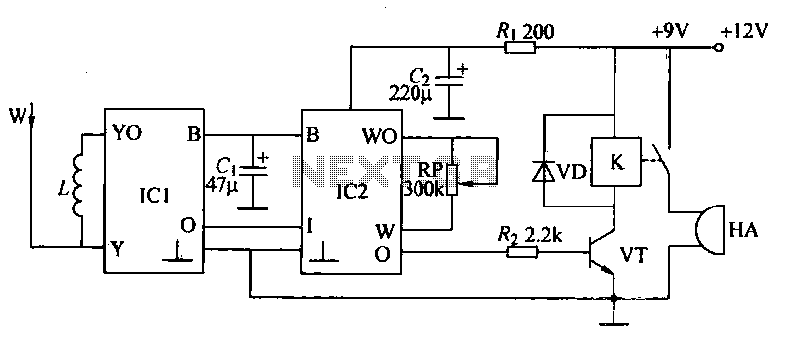
Frost Alarm

The thermistor utilized has a resistance of 15 kΩ at 25 degrees Celsius and 45 kΩ at 0 degrees Celsius. A suitable bead-type thermistor can be found in the Maplin catalog. The 100 kΩ potentiometer enables this circuit to activate over a broad temperature range. A small amount of hysteresis is introduced by the inclusion of a 270 kΩ resistor, which prevents relay chatter when the temperature is close to the switching threshold of this circuit.
The described circuit employs a thermistor, specifically a bead-type thermistor, which is a temperature-sensitive resistor whose resistance varies significantly with temperature changes. At 25 degrees Celsius, the thermistor's resistance is 15 kΩ, and at 0 degrees Celsius, it increases to 45 kΩ. This characteristic allows the thermistor to serve as a temperature sensor in various applications.
The circuit incorporates a 100 kΩ potentiometer, which provides adjustable resistance, thereby allowing fine-tuning of the temperature threshold at which the circuit activates. This flexibility is crucial for applications requiring specific temperature ranges, making the circuit adaptable to different environmental conditions.
To enhance the stability of the circuit and prevent unwanted relay activation, a 270 kΩ resistor is added. This resistor introduces hysteresis, a feature that creates a deadband around the switching threshold. This means that once the circuit is activated, the temperature must drop below a certain level before it deactivates, thus mitigating the risk of relay chatter—unwanted rapid switching that can occur when the temperature fluctuates around the threshold.
Overall, this thermistor-based circuit design effectively combines temperature sensing, adjustable thresholds, and hysteresis to create a reliable and versatile temperature control system suitable for various applications.The thermistor used has a resistance of 15k at 25 degrees and 45k at 0 degrees celsius. A suitable bead type thermistor is found in the Maplin catalogue. The 100k pot allows this circuit to trigger over a wide range of temperatures. A slight amount of hysteresis is provided by inclusion of the 270k resistor. This prevents relay chatter when temper ature is near the switching threshold of this circuit. 🔗 External reference
The described circuit employs a thermistor, specifically a bead-type thermistor, which is a temperature-sensitive resistor whose resistance varies significantly with temperature changes. At 25 degrees Celsius, the thermistor's resistance is 15 kΩ, and at 0 degrees Celsius, it increases to 45 kΩ. This characteristic allows the thermistor to serve as a temperature sensor in various applications.
The circuit incorporates a 100 kΩ potentiometer, which provides adjustable resistance, thereby allowing fine-tuning of the temperature threshold at which the circuit activates. This flexibility is crucial for applications requiring specific temperature ranges, making the circuit adaptable to different environmental conditions.
To enhance the stability of the circuit and prevent unwanted relay activation, a 270 kΩ resistor is added. This resistor introduces hysteresis, a feature that creates a deadband around the switching threshold. This means that once the circuit is activated, the temperature must drop below a certain level before it deactivates, thus mitigating the risk of relay chatter—unwanted rapid switching that can occur when the temperature fluctuates around the threshold.
Overall, this thermistor-based circuit design effectively combines temperature sensing, adjustable thresholds, and hysteresis to create a reliable and versatile temperature control system suitable for various applications.The thermistor used has a resistance of 15k at 25 degrees and 45k at 0 degrees celsius. A suitable bead type thermistor is found in the Maplin catalogue. The 100k pot allows this circuit to trigger over a wide range of temperatures. A slight amount of hysteresis is provided by inclusion of the 270k resistor. This prevents relay chatter when temper ature is near the switching threshold of this circuit. 🔗 External reference





